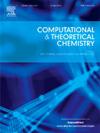Development of the C/F/S/O/H ReaxFF force field for the pyrolysis of PFHxS
IF 3
3区 化学
Q3 CHEMISTRY, PHYSICAL
引用次数: 0
Abstract
The pyrolysis mechanism of perfluorohexane sulfonic acid (PFHxS) is crucial for the harmless treatment of PFHxS. Herein, a ReaxFF reactive force field for PFHxS was developed, and ReaxFF molecular dynamics simulations were applied to study the pyrolysis behavior of PFHxS in the temperature range of 1500–3500 K. The homolytic cleavage of C![]() C bonds adjacent to the head group and the breakage of C
C bonds adjacent to the head group and the breakage of C![]() S bonds are predominant, accounting for 36 % and 27 % of the reactions, respectively. The final products of the pyrolysis of the tail group (-C6F13) are CF2 and CF3. As the temperature rises, the rate of defluorination increases, leading to higher yield of HF and CF4. Higher temperatures promote the formation of CF2O and CFO. CF2 reacts with other intermediates in the free radical pool to form species such as CF2O and CFO. Initially, HSO3 and SO2 are the main carriers of sulfur, and SO3 contributes less.
S bonds are predominant, accounting for 36 % and 27 % of the reactions, respectively. The final products of the pyrolysis of the tail group (-C6F13) are CF2 and CF3. As the temperature rises, the rate of defluorination increases, leading to higher yield of HF and CF4. Higher temperatures promote the formation of CF2O and CFO. CF2 reacts with other intermediates in the free radical pool to form species such as CF2O and CFO. Initially, HSO3 and SO2 are the main carriers of sulfur, and SO3 contributes less.

PFHxS热解C/F/S/O/H ReaxFF力场的建立
全氟己烷磺酸(PFHxS)的热解机理对PFHxS的无害化处理至关重要。为此,建立了PFHxS的ReaxFF反应力场,并应用ReaxFF分子动力学模拟研究了PFHxS在1500-3500 K温度范围内的热解行为。头基附近的CC键均裂和CS键断裂是主要的,分别占反应的36%和27%。尾基(-C6F13)热解的最终产物为CF2和CF3。随着温度的升高,脱氟速率加快,HF和CF4的收率提高。较高的温度促进了CF2O和CFO的形成。CF2与自由基池中的其他中间体反应生成CF2O和CFO等物质。初始阶段,HSO3和SO2是硫的主要载体,SO3的贡献较小。
本文章由计算机程序翻译,如有差异,请以英文原文为准。
求助全文
约1分钟内获得全文
求助全文
来源期刊

Computational and Theoretical Chemistry
CHEMISTRY, PHYSICAL-
CiteScore
4.20
自引率
10.70%
发文量
331
审稿时长
31 days
期刊介绍:
Computational and Theoretical Chemistry publishes high quality, original reports of significance in computational and theoretical chemistry including those that deal with problems of structure, properties, energetics, weak interactions, reaction mechanisms, catalysis, and reaction rates involving atoms, molecules, clusters, surfaces, and bulk matter.
 求助内容:
求助内容: 应助结果提醒方式:
应助结果提醒方式:


